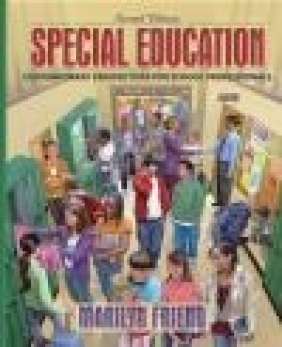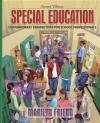Special Education
Special Education
- Producent: Allyn
- Rok produkcji: 2007
- ISBN: 9780205505319
- Ilość stron: 640
- Oprawa: Twarda
Niedostępna
Opis: Special Education
In the second edition of Marilyn Friend’s introductory special education text, emphasis is on contemporary concepts and evidence-based practices that prepare teachers for their evolving role in the education and well-being of students with disabilities and other special needs.
Informed by her years of experience working with students with disabilities and their teachers, this trusted author combines research-informed concepts and skills with practical information for educators working in this challenging age of high standards and accountability, curriculum access, inclusive practices, professional collaboration, student diversity, and legislative change. The second edition fully reflects NCLB and IDEA 2004 legislation and regulations so that readers understand the most recent expectations for professional educators and their students. Throughout the book, the author grounds the discussion in the realities of today’s classrooms in a way that is concrete and compelling to future teachers. The text strikes a careful balance between the immediate concerns of novice educators with the broader human needs and experiences of students with exceptionalities and their families.
Real People, Real Classrooms:
Chapter Opening Vignettesdescribe the experiences of three different students of varying ages as they relate to the topics discussed in each chapter and are referenced at key points in the chapter.
Firsthand Accountlets your students directly from teachers, students, parents, and school professionals as they share their own experiences and perspectives relating to life and learning with special needs.
Back to the Casesfeatures at the ends of every chapter revisit the students introduced in the chapter opening vignettes in light of the information presented in the chapter material. Questions are presented for analysis and discussion.
Real Research:
Validated Teaching Practices. Consistent with today’s standards of practices in the field of special education, this text is filled with contemporary information, teaching approaches, strategies, and tips that are always based on research findings. Evidence-based practice features include:
Specialized Instructionhighlights teaching applications for intensive instruction delivered by special education teachers in various educational settings.
Inclusion Matters presents teaching applications, service delivery options, and considerations for students with various needs in general education settings.
Positive Behavioral Supports illustrates the many positive, proactive ways to address student behavior/social issues as part of overall classroom teaching and learning.
Cutting Edge Information about Trends and Issues:
Technology Notes showcase fascinating new technology applications for teaching students with exceptional needs in special or general educational settings.
Professional Edge describes conceptual material and cutting edge information that connect theory to practice.
A unique chapter, Creating Partnerships through Collaboration (Chapter 4), provides a thorough introduction to collaboration that is essential for effective planning and implementation of programs.
Preface. Special Features. 1. Key Concepts for Understanding Special Education. Learning Objectives. What Is Special Education? What Are the Laws for Students with Disabilities? Who Receives Special Education? What Are the Recommended Practices That Characterize Today's Special Education? What Are the Perspectives of Parents and Families on Special Education? What Trends and Issues Currently Influence Special Education? Summary. Key Terms and Concepts. Back to the Cases Review, Discuss, Apply. 2. The Personnel and Procedures of Special Education. Learning Objectives. Who Are the Professionals Who Work in Special Education? How Do Students Become Eligible to Receive Special Education Services? What Is an Individualized Education Program? What Are the Services Students with Disabilities Receive? What Are the Options for Resolving Disagreements Regarding Special Education? What Are the Issues Related to Special Professionals and Procedures? Summary. Key Terms and Concepts. Back to the Cases Review, Discuss, Apply. 3. Multicultural Perspectives. Learning Objectives. What Is Culture? How Does Culture Affect the Learning Process? How Are Culturally Diverse Groups Represented in Special and Gifted Education? What Are Best Educational Practices for Diverse Learners with Exceptionalites? What Are the Perspectives of Parents of Diverse Exceptional Learners? What Are the Trends and Issues Affecting the Education of Diverse Exceptional Learners? Summary. Key Terms and Concepts. Back to the Cases Review, Discuss, Apply. 4. Creating Partnerships through Collaboration. Learning Objectives. What Is Collaboration? What Elements Are Necessary for Collaboration? How Is Collaboration Implemented in Schools? How Does Collaboration Involve Parents and Families? What Are Issues Related to Collaboration? Summary. Key Terms and Concepts. Back to the Cases Review, Discuss, Apply. 5. Students with Learning Disabilities. Learning Objectives. What Are Learning Disabilities? What Are the Characteristics of Individuals with Learning Disabilities? How Are Learning Disabilities Identified? How Do Learners with Learning Disabilities Receive Their Education? What Are Best Educational Practices for Students with Learning Disabilities? What Are the Perspectives of Parents and Families? What Trends and Issues Are Affecting the Field of Learning Disabilities? Summary. Key Terms and Concepts. Back to the Cases Review, Discuss, Apply. 6. Students with Attention Deficit Hyperactivity Disorder. Learning Objectives. What Is Attention Deficit Hyperactivity Disorder? What Are the Characteristics of Individuals with Attention Deficit Hyperactivity Disorder? How Is Attention Deficit Hyperactivity Disorder Identified? How Do Learners with Attention Deficit Hyperactivity Disorder Receive Their Education? What Are Best Educational Practices for Students with Attention Deficit Hyperactivity Disorder? What Are the Perspectives of Parents and Families? What Trends and Issues Are Affecting the Field of ADHD? Summary. Key Terms and Concepts. Back to the Cases Review, Discuss, Apply. 7. Students with Emotional and Behavior Disorders. Learning Objectives. What Are Emotional and Behavior Disorders? What Are the Characteristics of Individuals with Emotional and Behavior Disorders? How Are Emotional and Behavior Disorders Identified? How Do Learners with Emotional and Behavior Disorders Receive Their Education? What Are Best Educational Practices for Students with Emotional and Behavior Disorders? What Are the Perspectives of Parents and Families? What Trends and Issues Are Affecting the Field of Emotional and Behavior Disorders? Summary. Key Terms and Concepts. Back to the Cases Review, Discuss, Apply. 8. Students with Mental Retardation. Learning Objectives. What Is Mental Retardation? What Are the Characteristics of Individuals with Mental Retardation? How Is Mental Retardation Identified? How Do Learners with Mental Retardation Receive Their Education? What Are Best Educational Practices for Students with Mental Retardation? What Are the Perspectives of Parents and Families? What Trends and Issues Are Affecting the Field of Mental Retardation? Summary. Key Terms and Concepts. Back to the Cases Review, Discuss, Apply. 9. Students with Speech and Language Disorders. Learning Objectives. What Are Speech and Language Disorders? What Are the Characteristics of Individuals with Speech and Language Disorders? How Are Speech and Language Disorders Identified? How Do Learners with Speech and Language Disorders Receive Their Education? What Are Best Educational Practices for Students with Speech and Language Disorders? What Are the Perspectives of Parents and Families? What Trends and Issues Are Affecting the Field of Speech and Language Disorders? Summary. Key Terms and Concepts. Back to the Cases Review, Discuss, Apply. 10. Students with Deafness and Hearing Loss. Learning Objectives. What Are Deafness and Hearing Loss? What Are the Characteristics of Individuals Who Are Deaf or Hard of Hearing? How Is a Hearing Loss Identified? How Do Learners Who Are Deaf or Hard of Hearing Receive Their Education? What Are Best Educational Practices for Students Who Are Deaf or Hard of Hearing? What Are the Perspectives of Parents and Families? What Trends and Issues Are Affecting the Field of Deaf Education? Summary. Key Terms and Concepts. Back to the Cases Review, Discuss, Apply. 11. Students with Visual Impairments. Learning Objectives. What Is Visual Impairment? What Are the Characteristics of Individuals with Visual Impairments? How Is Visual Impairment Identified? How Do Learners with Visual Impairment Receive Their Education? What Are Best Educational Practices for Learners with Visual Impairments? What Are the Perspectives of Parents and Families? What Trends and Issues Are Affecting the Field of Visual Impairment? Summary. Key Terms and Concepts. Back to the Cases Review, Discuss, Apply. 12. Students with Autism Spectrum Disorder. Learning Objectives. What Are Autism Spectrum Disorders? What Are the Characteristics of Individuals with Autism Spectrum Disorders? How Are Autism Spectrum Disorders Identified? How Do Learners with Autism Spectrum Disorders Receive Their Education? What Are Best Educational Practices for Students with Autism Spectrum Disorders? What Are the Perspectives of Parents and Families? What Trends and Issues Are Affecting the Field of Autism Spectrum Disorders? Summary. Key Terms and Concepts. Back to the Cases Review, Discuss, Apply. 13. Students with Physical and Health Disabilities. Learning Objectives. What Are Physical and Health Disabilities? What Are the Characteristics of Individuals with Physical and Health Disabilities? How Are Physical and Health Disabilities Identified? How Do Learners with Physical and Health Disabilities Receive Their Education? What Are Best Educational Practices for Students with Physical and Health Disabilities? What Are the Perspectives of Parents and Families? What Trends and Issues Are Affecting the Field of Physical and Health Disabilities? Summary. Key Terms and Concepts. Back to the Cases Review, Discuss, Apply. 14. Students with Severe and Multiple Disabilities. Learning Objectives. What Are Severe and Multiple Disabilities? What Are the Characteristics of Individuals with Severe and Multiple Disabilities? How Are Severe and Multiple Disabilities Identified and Assessed? How Do Learners with Severe and Multiple Disabilities Receive Their Education? What Are Best Educational Practices for Students with Severe and Multiple Disabilities? What Are the Perspectives of Parents and Families? What Trends and Issues Are Affecting the Field of Severe and Multiple Disabilities? Summary. Key Terms and Concepts. Back to the Cases Review, Discuss, Apply. 15. Students Who Are Gifted and Talented. Learning Objectives. What Is Giftedness? What Are the Characteristics of Individuals Who Are Gifted and Talented? How Are Learners Who Are Gifted and Talented Identified? How Do Learners Who Are Gifted and Talented Receive Their Education? What Are Best Educational Practices for Students Who Are Gifted and Talented? What Are the Perspectives of Parents and Families? What Trends and Issues Are Affecting the Field of Gifted Education? Summary. Key Terms and Concepts. Back to the Cases Review, Discuss, Apply. References. Glossary. Index.
Szczegóły: Special Education
Tytuł: Special Education
Producent: Allyn
ISBN: 9780205505319
Rok produkcji: 2007
Ilość stron: 640
Oprawa: Twarda
Waga: 1.56 kg



















